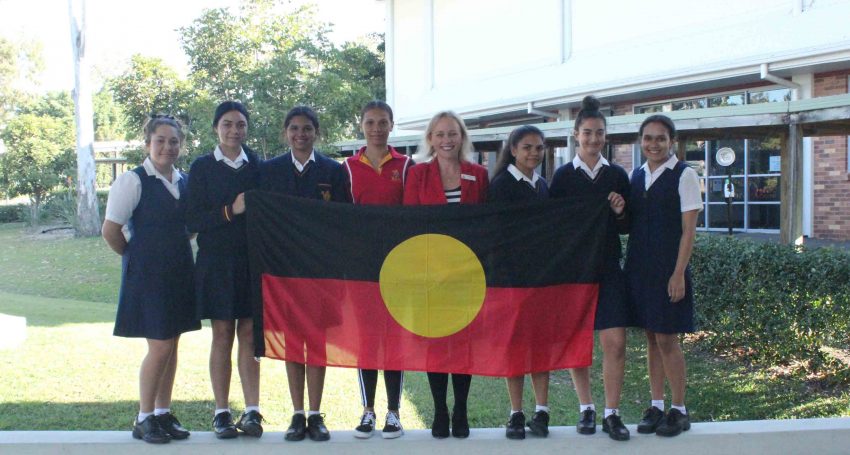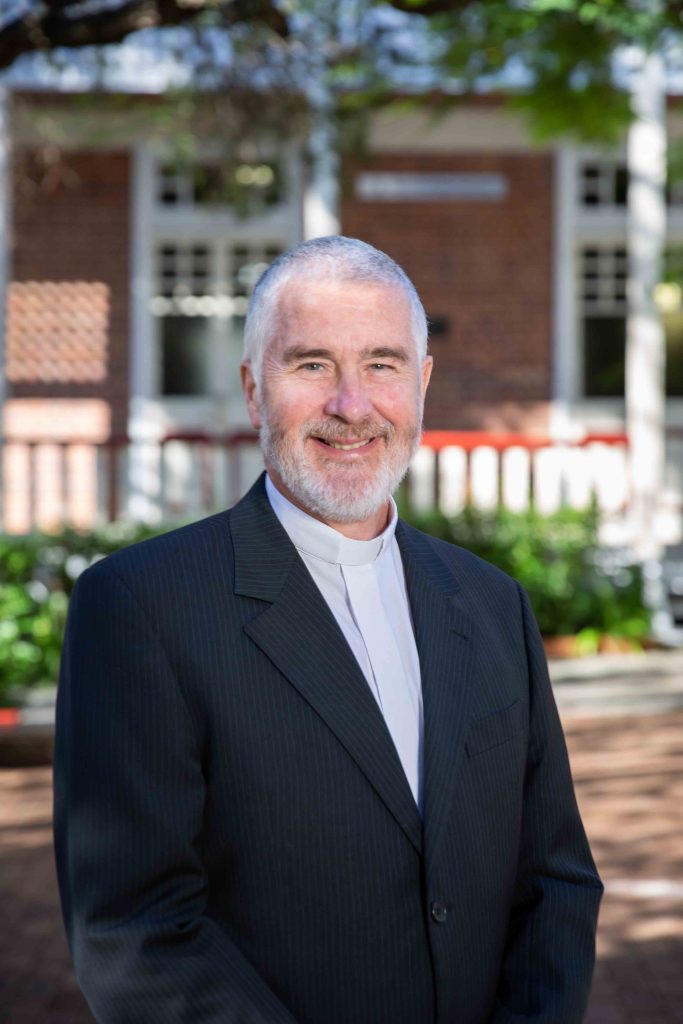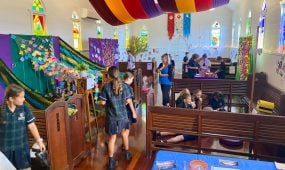Reconciliation: relationships and respect
Features
As part of our series on Reconciliation Action Plan achievements, the St Hilda’s School Chaplain shares how the school is embedding Indigenous culture and Reconciliation themes in their curriculum in novel ways, actively fostering relationships of respect between the whole school community and Aboriginal and Torres Strait Islander peoples and implementing students’ Reconciliation suggestions

Story Timeline
Reconciliation Action Plan achievements
- Pilgrimage to Wontulp-Bi-Buya (WBB) College
- PATSIMAC group creating welcome and honouring the culture of the Yugambeh people
- St Mark’s supporting First Nations constitutional reform
- New Anglicare SQ cards further Reconciliation journey
- Anglicare’s Reconciling Histories project
- SEQ Friends of Nungalinya College – building cultural bridges
- Reconciliation Prayer Spaces
- Exploring mission in a post-colonial Australian church
- First Nations ‘icons’ – a portal to Aboriginal and Torres Strait Islander Spiritualities
- Ancient Aboriginal practice meets Divine Christian call
- Stunning Aboriginal dot paintings to travel around our Diocese
St Hilda’s School on the Gold Coast is committed to fostering relationships and respect between Aboriginal and Torres Strait Islander peoples, and our School community.
As a valued and unique part of the fabric of our nation, St Hilda’s School has a number of initiatives to help integrate Indigenous culture into school life – starting from Pre-Prep all the way through to Senior School. Indigenous culture is also embedded within the curriculum.
Our School motto, Non Nobis Solum, means ‘not for ourselves alone’ and is perfectly aligned with the heart of Reconciliation. We know that the spirit of Reconciliation is most powerful in the context of relationships.
The Yugambeh language people are the traditional custodians of the land located on the Gold Coast. Within our School community, we have 16 Indigenous students from around Australia including the Gulf Country in Far North Queensland, the Northern Territory, and Casino, Grafton and Yamba in NSW.
St Hilda’s School begins each weekly assembly with an Acknowledgement of Country, while NAIDOC Week is celebrated each year in a special chapel service and activities throughout the School.
Our Pre-Prep play area includes the totemic symbols – Koala, Pelican and Echidna – of the
Kombumerri clan of the Yugambeh people. There is an Acknowledgement of Country on each of the Pre-Prep classroom doors and the opening greeting of each morning is given in Kombumerri. A local Kombumerri man, Uncle Boomerang, visits each term and spends a full day with the Pre-Prep students showing them different aspects of Indigenous culture such as bush tucker, dance, and arts and crafts. Our students also have access to a bush tucker garden.
Advertisement
From Prep to Year 2, Aboriginal stories and symbols are studied through units of work, which explore the development of oral language.
In Year 4, through the Multicultural Unit of study, students revisit these stories especially those that stem from The Dreaming. In Year 4 Science there is explicit reference to Aboriginal knowledge and culture. For example, the unit that studies soil and soil composition makes reference to ochre being used by Aboriginal people as part of their cultural practices.
We regularly review what we teach and share in our School libraries to ensure Indigenous content for class and individual reading. Our teachers consider how they might best integrate Aboriginal culture within set curricula. Junior School staff are also exploring how to include some Indigenous language learning more broadly into their curriculum.
Another great way to integrate cultures is through Art and our Senior students undertake a unit of work titled ‘Serendipity: Exploring the Creative Process through Indigenous Perspectives’. In this unit our students study two Indigenous artists and compare their work.
In studying the work of the traditional Aboriginal artist, John Mawurndjul, the students are asked to “write about the visual language and techniques used by Mawurndjul using art terminology e.g. colour schemes and their relevance to his ideas, line work and techniques.”
Advertisement
While examining the work of Judy Watson, who uses contemporary art techniques, one student wrote of her painting titled Sacred ground beating heart that “Watson creates a deeply intimate connection to the pulse and breath of the earth, the land, heat and air. The composition is of a heartland – more specifically, the heartland of the traditional, ancient owners of the Australian land.”
St Hilda’s School supports the Yalari program and we are proud of the ways in which our Yalari girls contribute to our School community. Our Principal, Dr Julie Wilson Reynolds, and our Boarding staff work closely with Yalari to provide pastoral care and support to our girls, and training for our staff.
Our Boarding community embraces the stories of our Indigenous girls in varied ways. The pastoral care of our girls is often intertwined with cultural sensitivities, and we acknowledge and support the importance of family in all our interactions.
Yalari staff regularly visit the school, especially the Boarding House and, as part of the celebrations of NAIDOC Week, a senior Yalari representative addressed the Year 11 and 12 students in Chapel. A member of staff has also been appointed to mentor our Indigenous students, so that they would be more comfortable in sharing their heritage and culture with other students at assemblies.
At St Hilda’s School, student voice is really important and we are pleased to embrace suggestions from our students. One example is the placement of three flag poles adjacent to our main oval, so that the Australian, Aboriginal and Torres Strait Islander flags can be flown.
The flags flying together symbolise the harmony and respect in our School community, and serve as a reminder to live together as one, and “not for ourselves alone”.

The Rev’d Patrick Duckworth, School Chaplain, St Hilda’s School





